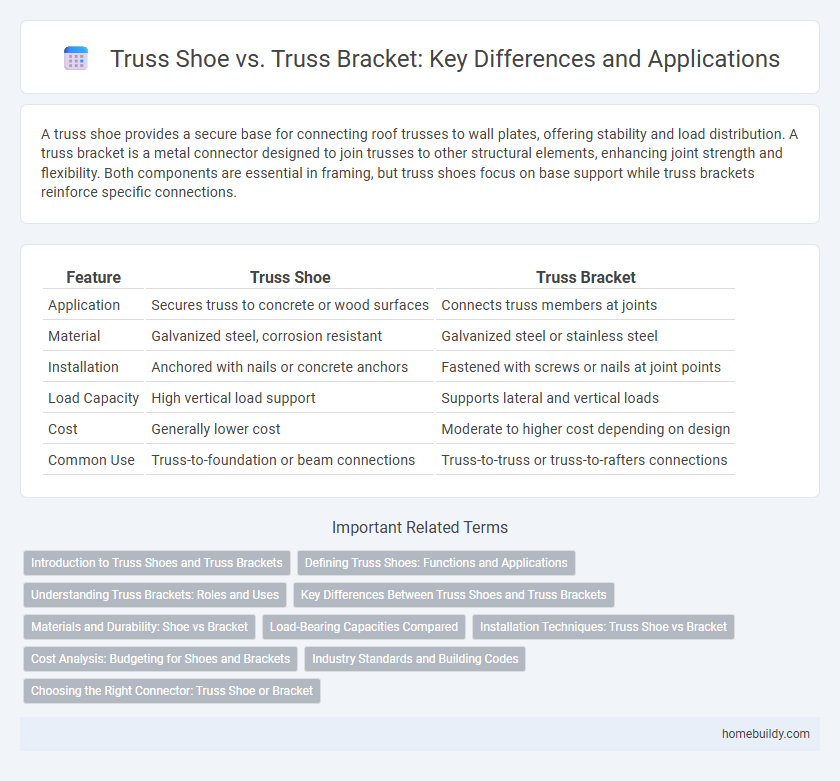A truss shoe provides a secure base for connecting roof trusses to wall plates, offering stability and load distribution. A truss bracket is a metal connector designed to join trusses to other structural elements, enhancing joint strength and flexibility. Both components are essential in framing, but truss shoes focus on base support while truss brackets reinforce specific connections.
Table of Comparison
| Feature | Truss Shoe | Truss Bracket |
|---|---|---|
| Application | Secures truss to concrete or wood surfaces | Connects truss members at joints |
| Material | Galvanized steel, corrosion resistant | Galvanized steel or stainless steel |
| Installation | Anchored with nails or concrete anchors | Fastened with screws or nails at joint points |
| Load Capacity | High vertical load support | Supports lateral and vertical loads |
| Cost | Generally lower cost | Moderate to higher cost depending on design |
| Common Use | Truss-to-foundation or beam connections | Truss-to-truss or truss-to-rafters connections |
Introduction to Truss Shoes and Truss Brackets
Truss shoes and truss brackets are essential components used in roof framing to secure trusses to the supporting structure, ensuring stability and load distribution. Truss shoes are U-shaped connectors designed to hold the truss bottom chord securely, offering strong lateral support and preventing movement. Truss brackets, often L-shaped or flat metal plates, provide versatile attachment options for various truss connections, allowing for flexible installation and enhanced structural integrity.
Defining Truss Shoes: Functions and Applications
Truss shoes are metal connectors designed to securely anchor the ends of roof trusses to wall plates, providing stability and load transfer in timber framing. Unlike truss brackets, which offer versatile joint connections, truss shoes primarily facilitate vertical support and resist uplift forces in structural frameworks. These connectors are essential in ensuring the durability and safety of roof assemblies by effectively distributing weight and preventing lateral movement.
Understanding Truss Brackets: Roles and Uses
Truss brackets secure and stabilize timber connections in roof and floor truss systems, providing critical support against lateral movements and load forces. Unlike truss shoes, which encase the truss bottom chord for direct anchoring, truss brackets focus on joining multiple members at specific angles to enhance structural integrity. Their versatile applications in heavy timber framing ensure efficient load transfer and resistance to shear and uplift forces in complex construction projects.
Key Differences Between Truss Shoes and Truss Brackets
Truss shoes are typically used to provide a secure base for truss ends, offering stability by encapsulating the truss and fastening it firmly to a support, whereas truss brackets primarily serve as metal connectors that attach trusses to other framing components, allowing for flexible angles and load distribution. The key differences include the truss shoe's design for direct end bearing and enhanced load transfer, contrasted with the truss bracket's role in providing angular support and lateral stability. Material thickness, fastening options, and application in construction methodologies further distinguish truss shoes from truss brackets in structural framing systems.
Materials and Durability: Shoe vs Bracket
Truss shoes are typically made from galvanized steel, offering enhanced corrosion resistance and long-lasting durability in outdoor and high-moisture environments. Truss brackets, often constructed from stainless steel or powder-coated metals, provide superior strength with added protection against wear and environmental factors. The choice between the two hinges on the specific project requirements, with truss shoes excelling in corrosion prevention and brackets delivering greater structural support.
Load-Bearing Capacities Compared
Truss shoes and truss brackets differ primarily in load-bearing capacities, with truss shoes typically designed to provide higher vertical load support due to their encasing design around the truss bottom chord, enhancing stability and load distribution. Truss brackets, while versatile and easier to install, generally offer lower load-bearing capacity, relying more on screw or nail fasteners which may not distribute loads as effectively as welded or fully encapsulated truss shoes. Engineers often select truss shoes for heavy-duty applications requiring maximum load support and truss brackets for lighter framing tasks where ease of installation is prioritized.
Installation Techniques: Truss Shoe vs Bracket
Truss shoes require precise alignment and anchoring to secure the bottom chord of the truss to the supporting structure, often involving nails or screws through pre-drilled holes for stability. Truss brackets, however, offer a more versatile and adjustable installation, allowing for quicker attachment with metal connectors and fewer fasteners due to their robust design. Both methods demand adherence to building codes, but brackets typically facilitate faster installation times and enhanced load distribution in complex framing layouts.
Cost Analysis: Budgeting for Shoes and Brackets
Truss shoes generally cost less than truss brackets, making them a more budget-friendly option for basic connections in wood framing. However, truss brackets offer greater strength and versatility, which can reduce long-term costs by minimizing repairs and replacements. When budgeting, consider the trade-off between upfront material costs and potential savings from enhanced durability provided by truss brackets.
Industry Standards and Building Codes
Truss shoes and truss brackets are designed to meet stringent industry standards such as ANSI/TPI 1 and ICC-ES reports, ensuring compliance with building codes like the International Building Code (IBC). Truss shoes provide superior load transfer and lateral support by fully encapsulating the truss end, enhancing structural integrity in high-wind or seismic zones. Truss brackets, while offering easier installation, must be carefully selected and installed to satisfy the minimum load requirements and fire-resistance ratings specified by local building regulations.
Choosing the Right Connector: Truss Shoe or Bracket
Selecting the right truss connector depends on load-bearing requirements and installation conditions. Truss shoes provide robust support for heavy vertical loads and secure the truss to the foundation, while truss brackets offer more flexibility for angled connections and lateral stability. Evaluating structural demands and connection angles ensures the optimal choice between a truss shoe and a truss bracket for enhanced safety and durability.
Truss shoe vs truss bracket Infographic

 homebuildy.com
homebuildy.com